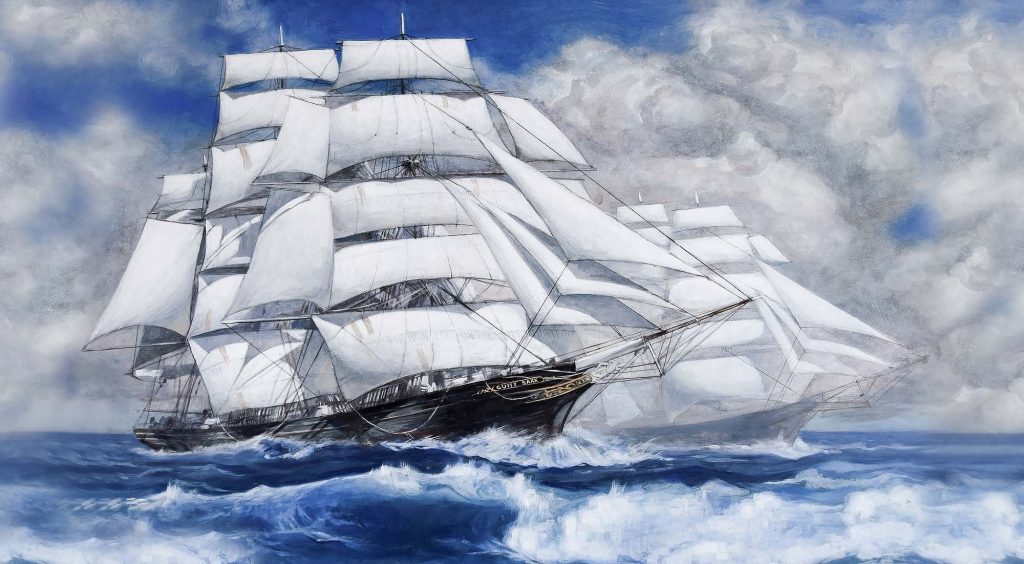A brief history of the Cutty Sark
 The extreme clipper ship Cutty Sark was built in Dumbarton Scotland by the firm of Scott & Linton for the shipping agents John Willis & Sons of London England. She was of composite construction (wood on an iron framework) and her purpose was to be faster than the Thermopylae in the competitive tea races from China to England. She was launched on November 22nd, 1869 having taken eleven months to build. She was built by the firm of Scott Linton. Mr William Scott, shipbuilder; Mr Hercules Linton, designer, naval architect and Lloyds Surveyor; Mr John Rennie, chief draughtsman who also designed the original sail plan and Mr Henry Henderson, master shipwright were the men responsible for her creation.
The extreme clipper ship Cutty Sark was built in Dumbarton Scotland by the firm of Scott & Linton for the shipping agents John Willis & Sons of London England. She was of composite construction (wood on an iron framework) and her purpose was to be faster than the Thermopylae in the competitive tea races from China to England. She was launched on November 22nd, 1869 having taken eleven months to build. She was built by the firm of Scott Linton. Mr William Scott, shipbuilder; Mr Hercules Linton, designer, naval architect and Lloyds Surveyor; Mr John Rennie, chief draughtsman who also designed the original sail plan and Mr Henry Henderson, master shipwright were the men responsible for her creation.
The original contract for the ship, signed on 1st February 1869, stated that she was to be completed in 6 month at a contracted price of £17.00 per ton and the final price not to exceed £16,150. The contract had a penalty clause of £5.00 per day if she was not completed in time. This led to the vessel being fitted out by the adjacent yard of William Denny & Brothers as well as the ultimate demise of Scott & Linton, who had given a ridiculously low price to start with. The demands of the resident surveyor, Captain George Moodie also caused delays because he was a stickler for quality and let nothing through that was not to his liking. This is probably why the vessel is still in existence today!
 She was named by Mrs Moodie after one of the witches (Nannie) in Robbie Burns’ poems Tam o’ Shanter. Cutty Sark translates as a ‘short shirt of blouse’ and if you read the poem, all will be revealed.
She was named by Mrs Moodie after one of the witches (Nannie) in Robbie Burns’ poems Tam o’ Shanter. Cutty Sark translates as a ‘short shirt of blouse’ and if you read the poem, all will be revealed.
The ship was towed to Greenock on the Clyde for rigging. She carried 29 sails amounting to 32,000 sq. feet of canvas in total.
She finally entered service under the captaincy of John Moodie and set sail from London for Shanghai on 16th February 1870, completing the return trip in 109 days. The epic voyage of 1872 made the ship become famous as her rudder had to be replaced twice whilst at sea and in spite of this delay (she was ahead of Thermopylae by 400 miles when the rudder broke) , she came into London only 7 days later than the Thermopylae. In the event she was eventually awarded the honour of winning the tea race.
Her life as a tea clipper was short lived with only eight round trips to Shanghai, culminating in 1877. The opening of the Suez Canal which favoured steam ships, reducing the journey by approximately 3000 miles, meant that sailing ships could no longer be competitive in the tea trade.
 From 1877 through to 1883, the Cutty Sark was used to carry a diverse range of cargo ranging from jute to coal, travelling all round the world in the process. In March 1880 her rig was reduced to make her more cost effective and in 1883 she entered the Australian wool trade.
From 1877 through to 1883, the Cutty Sark was used to carry a diverse range of cargo ranging from jute to coal, travelling all round the world in the process. In March 1880 her rig was reduced to make her more cost effective and in 1883 she entered the Australian wool trade.
This is where she again entered the annals of history by completing several record breaking passages under the captaincy of Captain R. Woodgett, the fastest being 69 days in 1887-8 from Newcastle N.S.W. to the Lizard.
In 1895 she was sold to the Portuguese firm of Ferreira & Co. and re-registered under the name of Ferreira. She then sailed the world carrying general cargo until May 1916 when she was dismasted and towed into Cape Town or repairs. Due to the scarcity of materials during the war years, she was converted to a barquentine and in 1922 the Ferreira pulled into Falmouth for repairs due to gale damage. She returned to Lisbon and was sold to another Portuguese owner and renamed Maria do Amparo.
Wilfred Dowman saw the ship in Falmouth and eventually purchased her in 1923 from the Portuguese for £3,750.00. The ship returned to Falmouth to be restored to her former glory and renamed Cutty Sark once again.
She was then use as a sail training ship. She remained in Falmouth until 1938 when she was again sold to the Incorporated Nautical Training College and towed to Greenhithe, Kent.
 She continued in her role as a sail training ship until the outbreak of war in 1939.
She continued in her role as a sail training ship until the outbreak of war in 1939.
In 1951 she was towed to the Thames as part of the Festival of Britain and noticed by Frank Carr, former Director of the National Maritime Museum, who formed the Cutty Sark Society in order to restore her. During the restoration she caught fire and was severely damaged.
The old ship has now been restored and looks beautiful, but will never go to sea again. She is too far gone. Cutty Sark now rests in her own specially built dry dock surrounded by glass and floating on air. She has become a museum to the Great Age of Sail and the China Tea Trade.



